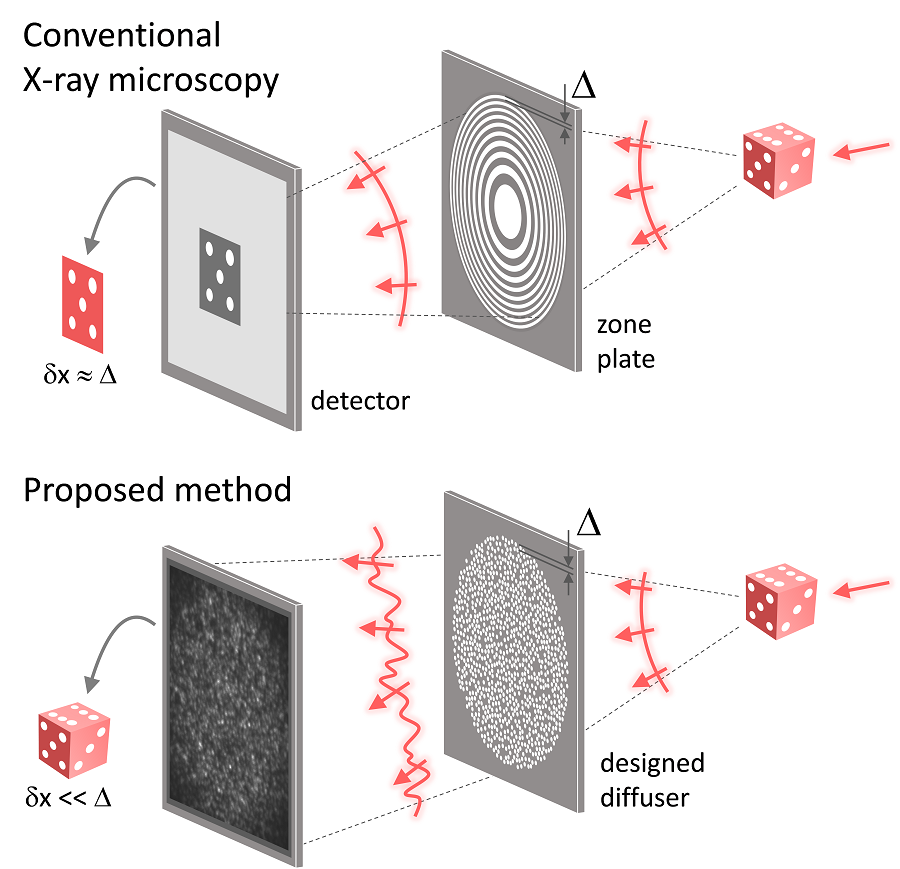The President of Korea Advanced Institute of Science & Technology (KAIST) Kwang Hyung Lee declared on April 12th that a collaborative research team headed by Professor YongKeun Park of the Department of Physics and Dr Jun Lim of the Pohang Accelerator Laboratory has been successful in developing a core technology that has the potential to defeat the resolution limitations of X-Ray microscopes currently available.

Figure 1. Designed diffuser as X-Ray imaging lens. a, Schematic of full-field transmission X-ray microscopy. The attenuation (amplitude) map of a sample is measured. The image resolution (dx) is limited by the outermost zone width of the zone plate (D). b, Schematic of the proposed method. A designed diffuser is used instead of a zone plate. The image resolution is finer than the hole size of the diffuser (dx << D). Image Credit: Korea Advanced Institute of Science & Technology.
This study, in which Dr. KyeoReh Lee took part as the first author, was reported on April 6th, 2023, in the journal “Light: Science and Application,” a world-renowned academic journal in optics and photonics.
Refractive lenses are not available in X-Ray nano microscopes. In an X-Ray microscope, a circular grating known as a concentric zone plate has been utilized rather than a lens. The quality of the nanostructure that comprises the plate helps identify the resolution of an image obtained using the zone plate. There are numerous hardships in fabricating and retaining such nanostructures, which fix the boundary to the level of resolution for X-Ray microscopy.
A new X-Ray nano microscopy technology was developed by the research group to resolve this issue. The research group suggested an X-Ray lens which is in the form of several holes that have been punched into a thin tungsten film and produces random diffraction patterns through diffracting incident X-Rays.
The research group, in a mathematical manner, determined that, paradoxically, the high-resolution information of the sample was completely contained in such random diffraction patterns and indeed managed to image the internal states of the samples.
In 2016, the imaging method that makes use of the mathematical properties of random diffraction was proposed and implemented in the visible light band for the first time by Dr. KyeoReh Lee and Professor YongKeun Park. This study makes use of the outcomes of earlier studies to resolve the challenging issues in the field of X-Ray imaging.
The image’s resolution of the constructed sample consists of no direct relationship with the size of the pattern that has been etched on the random lens. Based on this, the research group was successful in acquiring images with 14 nm resolution (around 1/7th the size of the coronavirus) by making use of random lenses made in a circular pattern with a 300 nm diameter.
The newly developed imaging technology is an important fundamental technology that could improve the resolution of X-Ray nano microscopy. This has been blocked by restrictions on the production of the zone plates.
In this study, the resolution was limited to 14 nm, but if the next-generation X-ray light source and high-performance X-ray detector are used, the resolution would exceed that of the conventional X-ray nano-imaging and approach the resolution of an electron microscope.
Dr. KyeoReh Lee, Study First Author and Co-Corresponding Author, Department of Physics, Korea Advanced Institute of Science & Technology
Lee added, “Unlike an electron microscope, X-rays can observe the internal structure without damaging the sample, so it will be able to present a new standard for non-invasive nanostructure observation processes such as quality inspections for semiconductors.”
The co-corresponding author, Dr. Jun Lim of the Pohang Accelerator Laboratory, stated, “In the same context, the developed image technology is expected to greatly increase the performance in the 4th generation multipurpose radiation accelerator which is set to be established in Ochang of the Northern Chungcheong Province.”
This study was performed with the assistance of the Research Leader Program and the Sejong Science Fellowship of the National Research Foundation of Korea.
Journal Reference
Lee, K., et al. (2023) Direct high-resolution X-ray imaging exploiting pseudorandomness. Light: Science & Applications. https://doi.org/10.1038/s41377-023-01124-3.